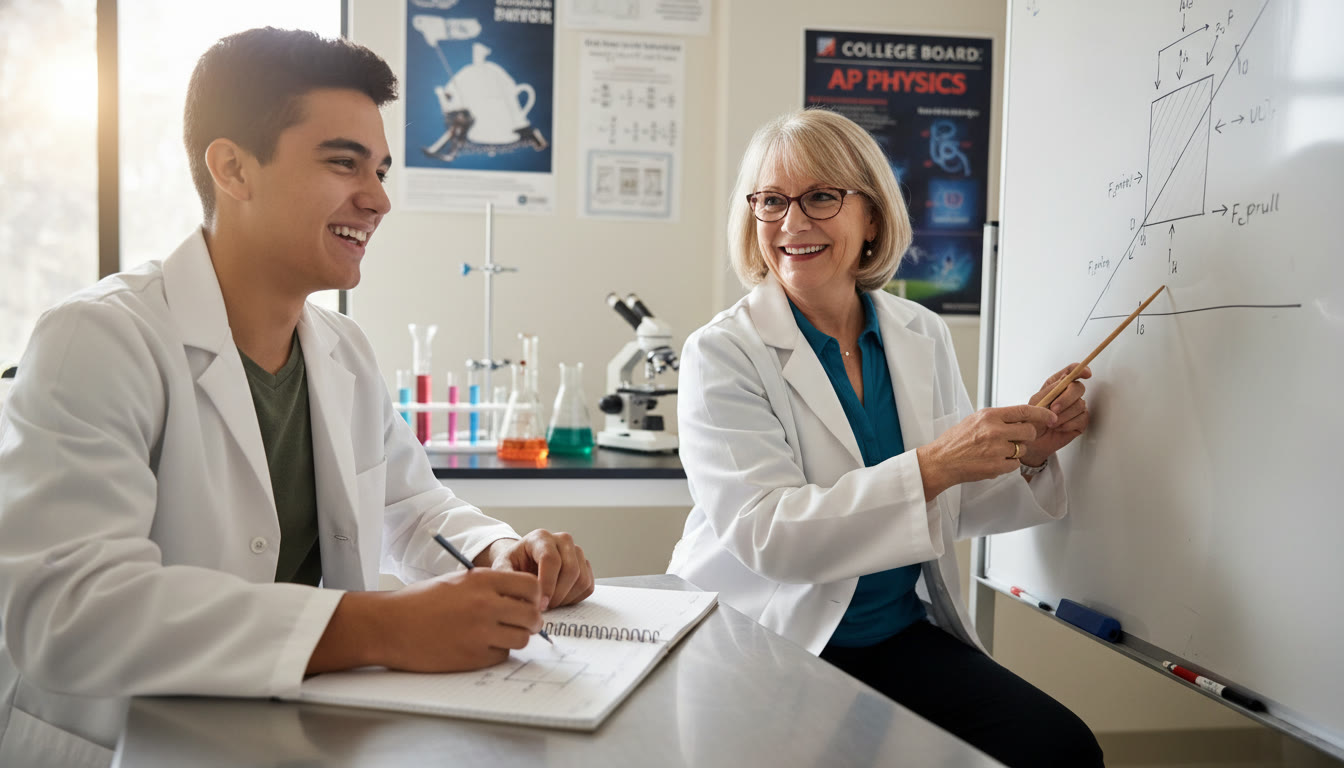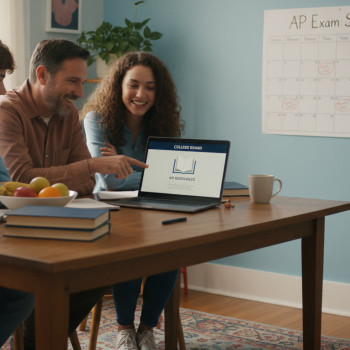Introduction: The Fork in the Road
If you’re aiming for an engineering major, AP Physics is one of those decisions that feels both exciting and a little intimidating. Do you pick AP Physics 1—the algebra-based, inquiry-driven course—or do you step up to AP Physics C, the calculus-based experience that more directly mirrors college physics for engineers? The short answer is: it depends. The long answer is what this article is for.
Here you’ll find a compassionate, practical walkthrough of what each course covers, who it suits, how colleges view them, and how to make the choice that aligns with your strengths, schedule, and long-term goals. I’ll also share study strategies, sample timelines, and honest comparisons so you and your parents can plan confidently. Along the way I’ll mention how Sparkl’s personalized tutoring (1-on-1 guidance, tailored study plans, expert tutors, and AI-driven insights) can help when you want targeted support.
Big Picture: What Each Course Is Built For
AP Physics 1 — The Conceptual Foundation
AP Physics 1 is an algebra-based, introductory college-level physics course. Its focus is on conceptual understanding, experimental design, and problem solving without the heavy use of calculus. If you like hands-on labs, thoughtful reasoning, and steady conceptual gains, Physics 1 gives you a strong foundation in mechanics, energy, momentum, rotational motion, oscillations, and fluids.
Who it’s great for: students who are newer to advanced math (e.g., not comfortable with calculus yet), those who want a broad introduction to physics, or learners who value lab experience and conceptual mastery first.
AP Physics C — The Calculus-Powered Step-Up
AP Physics C is calculus-based and offered in two flavors: Mechanics, and Electricity & Magnetism (E&M). Engineering-minded students most often take AP Physics C: Mechanics first, because it mirrors the first-semester college physics course for many engineering curricula. Expect derivatives and integrals in motion problems, a tighter mathematical rigor, and problems that resemble calculus-based university homework.
Who it’s great for: students comfortable with calculus or taking it concurrently, people who want direct preparation for college engineering courses, and those aiming to demonstrate readiness for technical majors.
Course Content at a Glance
Here’s a clean comparison so you can see what topics appear where and which skills each course emphasizes.
| Feature | AP Physics 1 | AP Physics C: Mechanics |
|---|---|---|
| Math Level | Algebra and trigonometry | Calculus (derivatives and integrals) |
| Core Topics | Kinematics, Newton’s laws, energy, momentum, rotation, oscillations, fluids | Kinematics, Newton’s laws, energy, momentum, rotation, gravitation (with calculus) |
| Exam Style | Multiple-choice and free-response emphasizing conceptual reasoning and lab skills | Multiple-choice and free-response with calculus-based derivations and quantitative problems |
| Typical College Credit Use | Credit or placement for algebra-based introductory courses at some colleges | Often considered equivalent to a calculus-based college physics semester — highly relevant for engineering majors |
| Lab Work | Emphasized; strong experimental component | Also required; lab work often more mathematically framed |
How Colleges See These APs (and Why That Matters)
Colleges look for both rigor and readiness. For an engineering applicant, AP Physics C signals that you’ve already worked through calculus-based physics problems—very close to the way first-year engineering physics courses operate. AP Physics 1 shows strong conceptual grounding and lab experience, and it’s not uncommon for colleges to award credit or allow placement out of certain introductory courses for strong scores.
Important nuance: colleges differ in what they accept and how they place. Some schools grant credit for AP Physics 1, some only for Physics C, and many use scores to place you into a suitable course rather than giving outright credit. If you have a dream school, check their AP credit policies early. Also remember that admissions officers value an intentional academic plan—choosing the course that best fits your background and schedule looks stronger than randomly trying to maximize AP names on a transcript.
Which Is Right for You? Practical Decision-Making
Make the choice with these three lenses: academic readiness, scheduling logistics, and long-term goals.
1) Academic Readiness
- If you’ve completed or are taking calculus (or are comfortable with limits, derivatives, and basic integrals), Physics C is a natural fit.
- If you haven’t taken calculus yet or prefer to build physics intuition first, Physics 1 is excellent and will still prepare you for future calculus-based work.
- Consider your problem-solving style: do you enjoy mathematical derivations (C) or conceptual modeling and lab inquiry (1)?
2) Scheduling and Course Sequence
Common paths for engineering hopefuls include:
- Take AP Physics 1 in 10th or 11th grade; take AP Calculus in 11th or 12th; then take Physics C concurrently with or after calculus.
- Skip Physics 1 and go directly to Physics C if you’ve already completed calculus or are taking it simultaneously.
- Take only Physics 1 if your school schedule or interest doesn’t support calculus in time—then use first-year engineering courses in college to deepen calculus-based physics skills.
3) College and Career Goals
If your aim is a top engineering program, Physics C often aligns more directly with the expectations of those departments. However, a strong score in Physics 1 plus rigorous math coursework and engineering-related extracurriculars (robotics, internships, research) will also make you a competitive candidate.
Example Study Plans: When to Take Which Course
Below are three practical timelines—conservative, balanced, and accelerated—based on when you want to take calculus and how confident you are with math.
| Plan | Grade 10 | Grade 11 | Grade 12 |
|---|---|---|---|
| Conservative | Honors Physics or AP Physics 1 | Algebra II and Precalculus; retake AP Physics 1 exam prep | AP Calculus AB/BC; college first-year physics in summer or after HS |
| Balanced | AP Physics 1 | AP Calculus AB; begin prep for Physics C | AP Physics C (Mechanics) and AP Calculus BC or AB continued |
| Accelerated | AP Calculus AB or BC | AP Physics C (Mechanics); AP Calculus BC support | AP Physics C E&M or advanced engineering coursework |
Study Strategies That Work (and How Tutoring Helps)
Physics is a language—a mix of conceptual storytelling and math grammar. These strategies will help you translate class time into exam-ready knowledge.
Active Learning Over Passive Reading
- Do problems actively: after reading a concept, immediately solve 2–3 problems that force you to apply it.
- Explain solutions aloud or write them as if teaching a friend; that exposes gaps.
Lab Work Is Not Optional
- For Physics 1, labs are often a significant part of the course and exam—practice designing experiments and interpreting data.
- For Physics C, use labs to connect calculus to physical behavior (e.g., relating acceleration graphs to force observations).
Math Practice for Physics C
- Master derivatives and integrals in physics contexts—kinematic equations, work as an integral of force, center of mass calculations.
- Practice translating physical descriptions into differential equations, then solving or approximating them.
Timed Practice Exams
- Simulate the hybrid digital format if possible: practice multiple-choice sections and timed free-response handwriting to mirror the exam experience.
Use Targeted Tutoring When Needed
One-on-one tutoring can accelerate progress. Personalized tutoring—like Sparkl’s 1-on-1 guidance—offers tailored study plans, expert tutors who can explain calculus-based derivations step-by-step, and AI-driven insights that spot your weak topics and recommend focused practice. Tutoring is especially useful when moving from Physics 1 to Physics C, since the leap to calculus-based reasoning is where many students stall.
Exam Tips Specific to Each Course
AP Physics 1 Exam Tips
- Master diagrams: many free-response prompts expect clear force diagrams and representation skills.
- Lab-report literacy: be comfortable describing experimental setups, sources of error, and data interpretation.
- Units and reasoning: always include units and justify steps—partial credit often rewards clear logic.
AP Physics C Exam Tips
- Practice calculus steps cleanly: show derivative or integral work when appropriate; messy algebra leads to avoidable errors.
- Know when to use conservation laws versus Newton’s laws with calculus—both approaches can solve many problems.
- Calculator fluency: be efficient with your graphing or scientific calculator for integrals, kinematics, and algebraic manipulation.
Real-World Context: Why Engineers Choose Physics C
Engineering problems in the real world rarely stay at algebra level. When designing structures, circuits, or control systems, engineers use calculus—rates of change, integrals of stress or charge, differential equations for dynamic systems. By taking Physics C in high school, you start thinking with calculus in physical systems earlier. That alignment can make your first semester of college less about catching up and more about accelerating into design and application.
When Physics 1 Is Actually the Better Move
There are many valid reasons to choose Physics 1:
- If your math readiness isn’t there yet, Physics 1 builds intuition without penalizing you for not having calculus.
- If you want to strengthen lab skills and conceptual reasoning before tackling calculus-based problems.
- If your schedule prevents you from taking calculus concurrently with Physics C—Physics 1 keeps your transcript rigorous while you build math skills.
Combining the Two: A Powerful One-Two Punch
If your school allows it and your schedule supports it, taking Physics 1 followed by Physics C is ideal. Physics 1 establishes deep conceptual understanding and experimental technique; Physics C layers calculus and mathematical power on top of that foundation. This combination tells colleges you understand physics both intuitively and analytically.
Sample Weekly Study Plan (8 Weeks Before Exam)
This plan assumes a student aiming for a top score; adjust pacing to fit your baseline. If you’re taking Physics C and calculus concurrently, carve out extra time for math practice.
| Week | Focus | Weekly Tasks |
|---|---|---|
| 1 | Concept review | Review key units, create a formula sheet, set baseline practice test |
| 2 | Problem types | Targeted practice for common free-response formats; timed sections |
| 3 | Lab and data interpretation | Practice experiment analysis and write-ups, error analysis drills |
| 4 | Math mechanics | Derivatives/integrals practice in physical contexts (for C); algebraic manipulations for 1 |
| 5 | Mixed practice | Full timed exam simulation; review mistakes |
| 6 | Target weak spots | Drill weak areas with problem sets and targeted tutoring sessions |
| 7 | Polish free-response | Practice clear, concise written answers; get feedback from teacher or tutor |
| 8 | Rest and confidence | Light review, sleep optimization, test-day logistics |
How to Use Tutoring Efficiently
If you bring a tutor into your plan, use them smartly:
- Ask for a diagnostic to identify high-impact weaknesses early.
- Request 1-on-1 sessions focused on problem-solving strategies and exam formats, not just content recitation.
- Have the tutor simulate exam conditions and provide timed feedback.
Sparkl’s personalized tutoring can fit into each of these steps: their expert tutors can run diagnostics, create tailored study plans that align with your school calendar, and use AI-driven insights to track progress—so you study smarter, not just harder.
Common Questions From Students and Parents
Q: Will taking Physics C guarantee college credit?
A: Not automatically. Many colleges award credit or advanced placement for strong scores, but policies vary. Physics C more often maps to calculus-based college courses, so it’s more likely to be accepted by engineering programs. Always check institution-specific AP credit policies.
Q: Can I switch from Physics 1 to Physics C mid-year?
A: It’s possible but depends on your school and your math preparation. If you plan to switch, add intensive calculus review and targeted tutoring to bridge gaps. A transitional plan that focuses on calculus applications in physics speeds the move.
Q: Which AP is more respected by admissions?
A: Admissions teams look for rigor and fit. Physics C shows calculus readiness and is often preferred for engineering applicants, but a strong Physics 1 score combined with robust math coursework and engineering experiences is equally compelling.
Final Thoughts: Make the Choice That Builds Confidence
The best path is the one that aligns with your current skills and moves you toward your goals without burning you out. Physics C is a great signal for engineering readiness, but it’s also math-intensive—so make sure you’re ready. Physics 1 is an outstanding alternative that builds a deep conceptual portfolio and strong lab skills.
If you want to accelerate safely, consider taking Physics 1 first and then Physics C once you’ve either completed or are comfortable with calculus. Pair either path with focused practice, timed exams, and targeted tutoring when you need guided acceleration. Personalized tutoring, like the offerings from Sparkl with 1-on-1 guidance, tailored study plans, expert tutors, and AI-driven insights, can be the nudge that turns a ‘maybe’ into a confident ‘yes.’

Ready-Made Checklist for Decision Day
- Do you have calculus completed or in progress? If yes, lean Physics C.
- Do you enjoy labs and conceptual challenges more than calculus manipulations? If yes, Physics 1 is great.
- What do your target colleges prefer? Check their AP credit policies and course placement guidelines.
- Can your schedule accommodate both courses across two years? If so, consider Physics 1 then Physics C.
- Have you built a study plan with diagnostics, targeted practice, and at least one tutor or mentor? If not, set that up now.
Parting Advice: Growth Mindset Beats Course Labels
Labels like “Physics 1” and “Physics C” matter—but only as signposts, not destiny. Admissions teams, professors, and employers want students who can learn, adapt, and think critically. Whether you choose Physics 1 or Physics C, focus on developing curiosity, mathematical fluency, and the ability to communicate scientific ideas clearly.
When you pair intentional course choices with steady practice and targeted support—especially personalized tutoring when you need it—you’ll be in the best position to succeed in college and beyond. If you want, start with a short diagnostic or a planning conversation to map the path that fits your strengths and ambitions.

Next Steps
Talk with your physics teacher and math counselor, outline your next two years of coursework, and consider a tutoring plan that targets the leap you want to make. If you’d like a sample personalized study plan or a diagnostic to figure out where you should start, reach out to a trusted tutor or tutoring program and ask for a focused plan for AP Physics success.
Good luck—choose the path that builds confidence, curiosity, and momentum toward the engineer you want to become.


















No Comments
Leave a comment Cancel